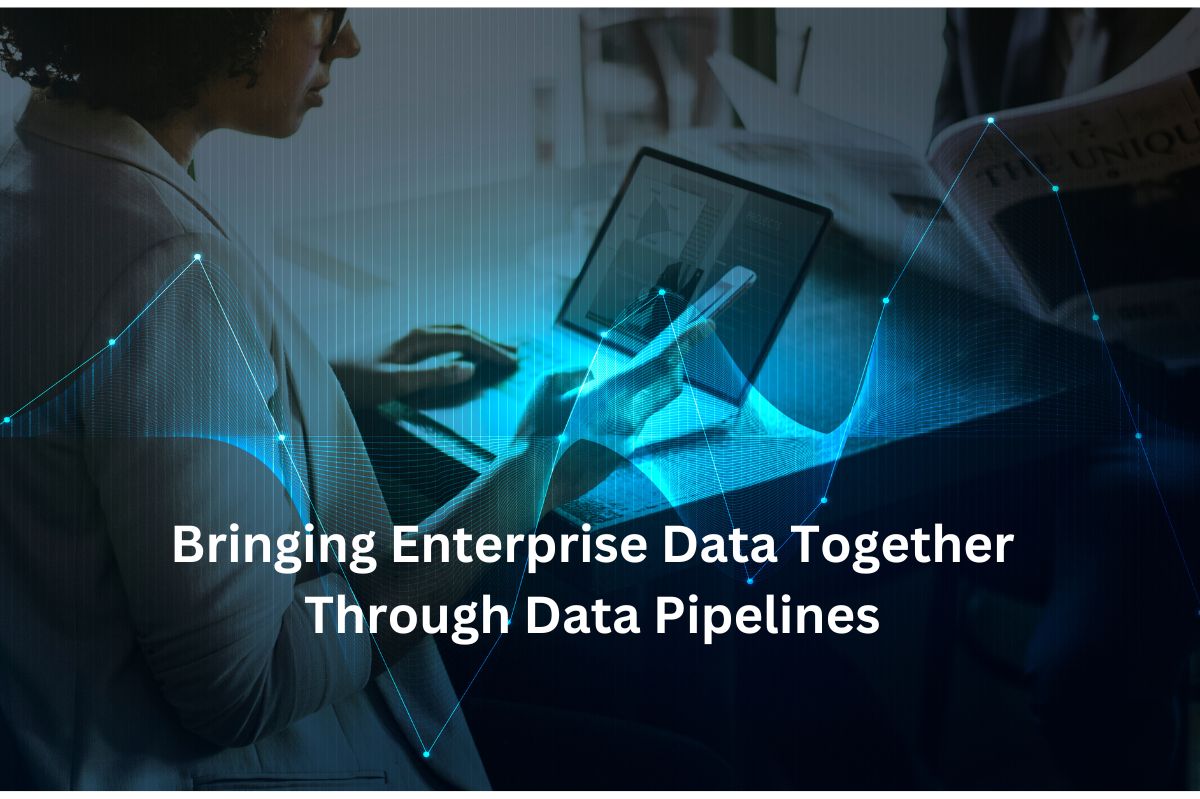Bringing Enterprise Data Together Through Data Pipelines

Businesses constantly generate vast amounts of data from different sources in today’s data-driven world. This data includes everything from supply chain and social media analytics to website traffic and customer interactions. Collecting this enterprise data alone is not enough – organizations must be able to analyze and process it to generate valuable insights. And this is where data pipelines come into play.
But what is a data pipeline? What are the key components of a data pipeline? And what are some best practices to consider when bringing enterprise data together through data pipelines? Here is a detailed overview of data pipelines and their role in enterprise data management.
Table of Contents
What is a Data Pipeline?
A data pipeline is a series of processes that pull data from different sources and transform it into a more usable format before loading it into a designated storage space. It facilitates the efficient movement of data between multiple systems. Also, it ensures data is consistent and accurate across different systems.
Data pipelines are used for several purposes, including integration, analysis, and warehousing. They are utilized by data scientists and engineers to automate data processing activities. This frees up resources and time for other enterprise activities.
Data pipelines are designed with different complexities and purposes depending on their intended use. For example, HomeServe uses a streaming data pipeline that transfers data associated with their lead detection tool, LeakBot, to Google BigQuery. Data scientists analyze this data to continuously fine-tune the machine learning (ML) model that powers LeakBot.
Similarly, Macy’s utilizes a data streaming pipeline that moves change data from on-premise storage solutions to Google Cloud. This allows them to provide a smooth shopping experience to customers, whether they shop in-store or online.
Components of a Data Pipeline
The data pipeline architecture is multi-layered. Each substructure feeds into the next – this process repeats until data arrives at its destination. Although the design may differ depending on factors such as data size, frequency, and type, here are the key components of the data pipeline infrastructure:
1. Data Sources
As the name suggests, these are the origins of data gathered and processed within a data pipeline. Data sources can hold varying types of data. For instance, semi-structured data from XML or JSON files, unstructured data from social media and text documents, and structured data from databases.
Here are some common data sources:
- MongoDB
- Application programming interfaces (APIs) (such as Twitter API),
- MySQL
- Stream processing APIs (e.g., Apache Kafka)
- External data providers (e.g., weather APIs)
2. Ingestion
Ingestion is the process of collating data from different sources and bringing them into your data pipeline. The ingestion components read data from the various sources and load it into your pipeline for further processing.
Data ingestion involves using APIs provided by each data source to read data. However, before writing the code that will call the APIs, you must figure out the data you wish to extract. This process is called data profiling. It involves examining data for its structure and features. Also, it requires you to evaluate data to determine how well it suits your business purpose. Once the data is profiled, it is ingested through streaming or as batches.
3. Transformation
Data is often extracted from different sources in raw format. Once it is ingested, its format or structure may need to be changed. And that’s where transformation comes in.
Data transformation includes mapping coded values to more detailed ones, aggregation, and filtering. One commonly used form of transformation is the combination. It features database joins, where associations encoded in relational data models bring related tables, records, and columns together.
The timing of data transformations depends on which replication process you use in your pipeline. Extract, Transform, and Load (ETL) and Extract, Load, and Transform (ELT) are common technologies used in transformation.
- ETL is a slightly older technique often used with on-premises data warehouses. It involves transforming data before loading it to its destination.
- ELT, on the other hand, is a modern transformation technique leveraged with cloud-based data warehouses. It loads data before applying any transformations. Once loaded, data consumers can implement their own transformations.
4. Destinations
Once the suitable data is ingested, it has to be stored in an appropriate destination for future processing. It involves assembling and storing data in various storage solutions, such as databases, cloud data warehouses, and data lakes. This stage may include indexing, partitioning, and duplicating data for effective data processing and retrieval.
Some common examples of storage solutions used include:
- Relational databases (e.g., MySQL)
- Data lakes (e.g., Amazon S3 and Apache Hadoop)
- NoSQL (e.g., MongoDB)
- Data warehouses (e.g., Google BigQuery and Amazon Redshift)
Data warehouses are the primary destinations for data duplicated through your pipeline. These unique enterprise data management solutions store all cleaned, transformed, and mastered data in a centralized repository for reporting, business intelligence, and analytics.
However, if the data is semi-structured or unstructured, it flows into data lakes. Data scientists can use this data to generate valuable insights and identify hidden patterns.
Best Practices for Enterprise Data Integration Through Data Pipelines
Here are some best practices to consider when bringing enterprise data together through data pipelines:
- Implement robust monitoring tools. Data pipelines are complex, consisting of software, networking components, and hardware. All these elements are subject to failure. Therefore, you should implement monitoring and logging mechanisms to keep your pipeline functional. This will alert you of any performance issues, helping you optimize its efficiency.
- Prioritize security and compliance. Implement access controls, encryptions, and other security measures to protect sensitive data in your pipeline. This will boost compliance with various data privacy regulations.
- Implement data governance measures. Robust data governance is crucial in integrating enterprise data through data pipelines. It helps you define data usage policies, ownership, and lineage, ensuring consistency and accuracy.
- Documentation and versioning. Document your data pipelines and every change you make to them. This makes it easier for others to understand and maintain the pipelines.
Plan for scalability. With time, your data volume will grow. So, when building data pipelines for bringing enterprise data together, ensure they can scale horizontally to handle the increased load in the future.
Final Thoughts
Bringing enterprise data together through data pipelines can help you achieve your data transformation goals. Also, it increases the effectiveness and efficiency of enterprise data management. However, building and managing these data pipelines is a continuous process. So, as new data sources emerge, data volumes increase, or business needs change, you must regularly monitor and fine-tune your data pipelines. This will help you adapt to the ever-changing requirements and ensure your data remains accessible and valuable for analysis and decision-making.
Also Read : How To Face Changes In The Management Of Technological Resources In Companies
